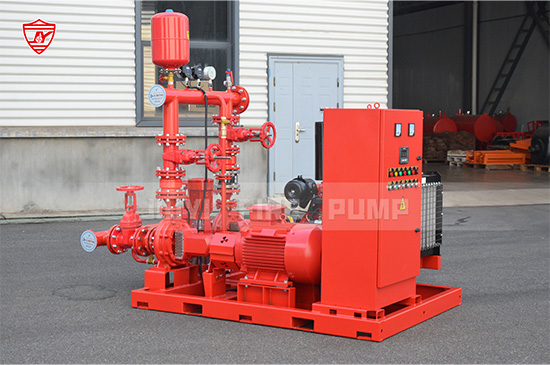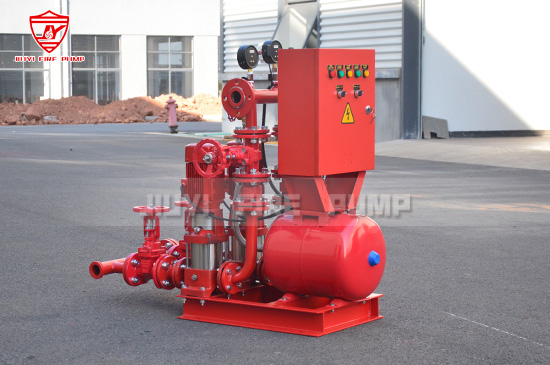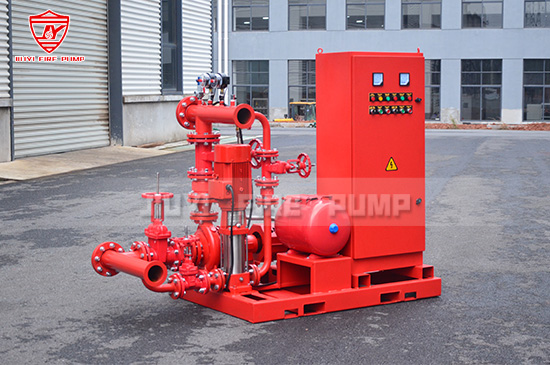When discussing fire pump systems, one of the most common questions is: Do all fire pumps need a jockey pump? The short answer is no—not all fire pumps require a jockey pump. However, in many modern fire protection systems, jockey pumps play a critical role in maintaining pressure and ensuring that the fire pump only operates when truly needed.
This article will explore the jockey pump's function, when it is required, and how it integrates with different types of fire pump systems.

A jockey pump, also known as a pressure maintenance pump, is a small-capacity pump installed alongside the main fire pump. Its purpose is not to fight fires directly but to maintain the system pressure within the fire protection piping network.
In a fire sprinkler or hydrant system, small pressure drops may occur due to minor leaks, system testing, or temperature fluctuations. Without a jockey pump, the main fire pump could start unnecessarily every time pressure decreases. Since fire pumps are designed for full-capacity operation, this would result in excessive wear, high energy consumption, and premature failure.
The jockey pump prevents this by automatically turning on to restore system pressure for minor fluctuations, allowing the main fire pump to only engage during real fire emergencies.
The straightforward answer is no—not every fire pump system has or needs a jockey pump.
Whether a jockey pump is necessary depends on several factors:
System Size
Small fire protection systems, such as those protecting a single room or building with low water demand, may not need a jockey pump. Pressure fluctuations in these systems can often be handled without additional equipment.
Water Source Stability
If the fire pump is connected to a municipal water supply with stable pressure, a jockey pump may not be required. However, in systems using tanks or reservoirs, jockey pumps are more common.
Local Codes and Standards
NFPA 20 (Standard for the Installation of Stationary Fire Pumps) recommends jockey pumps for most medium to large fire pump installations. Some authorities having jurisdiction (AHJs) mandate them.
System Complexity
Large facilities, high-rise buildings, industrial plants, or distribution centers often require jockey pumps to maintain reliable pressure across extensive piping networks.
Maintenance Considerations
Where the fire pump is rarely activated, a jockey pump ensures the system remains operational without unnecessary cycling of the main pump.
Even though not all fire pumps require jockey pumps, they are widely used because of the benefits they provide:
Prevents Main Pump Short-Cycling
Reduces unnecessary wear and tear by keeping the main fire pump from starting for minor pressure drops.
Maintains Constant Pressure
Ensures the fire protection system stays pressurized and ready at all times.
Energy Savings
A jockey pump consumes significantly less power than a full-size fire pump.
Longer Fire Pump Life
Extends the service life of the main fire pump by reducing its operating hours.
Compliance with Standards
Helps meet NFPA 20 recommendations and local fire code requirements.
Although valuable, jockey pumps are not always necessary. A fire pump system might operate without one in situations such as:
Very Small Systems: For example, small commercial units with minimal fire protection demand.
Stable Municipal Pressure: If the city’s water supply maintains consistent pressure, there may be little need for a jockey pump.
Direct Pump Activation Design: Some specialized systems are designed to start the main pump whenever pressure drops, regardless of how minor.
That said, even in cases where it’s not required, many designers still choose to include a jockey pump for added reliability and efficiency.
If a jockey pump is required, proper sizing is essential. NFPA 20 provides guidelines:
Flow Rate: The jockey pump should be sized to make up for small leakage losses in the system, typically 1–3 gallons per minute (GPM) for sprinklers, though larger systems may need more.
Pressure Setting: The jockey pump should be set to start at a slightly higher pressure than the fire pump start point. This ensures it engages first for small drops.
Power Source: Jockey pumps are usually electric-driven because of their small size and continuous readiness.
Correct installation and programming are key to ensuring smooth operation. An undersized jockey pump may not handle pressure drops, while an oversized one could interfere with fire pump operation.
Like any equipment in a fire protection system, jockey pumps require regular inspection and maintenance:
Weekly Checks – Ensure the pump cycles properly when pressure drops slightly.
Pressure Settings – Verify that the start/stop pressure settings are correct and coordinated with the fire pump.
Electrical Components – Inspect motor connections, control panel, and automatic start features.
Leak Inspection – Ensure system leaks are minimal to prevent unnecessary jockey pump cycling.
Routine testing ensures the jockey pump is reliable and will perform its role when needed.

High-Rise Buildings
Tall buildings experience significant pressure fluctuations due to elevation differences. Jockey pumps maintain stable pressure throughout the risers.
Industrial Plants
Large-scale facilities with extensive fire sprinkler networks rely on jockey pumps to keep pipes pressurized without activating large fire pumps unnecessarily.
Warehouses and Logistics Centers
Wide-area coverage with hydrants and sprinklers requires constant pressure, best achieved with jockey pumps.
Hospitals and Airports
Where reliability is critical, jockey pumps provide an extra layer of assurance that the system remains charged and ready.
While not mandatory in every installation, NFPA 20 strongly recommends jockey pumps for most fire pump systems. Many insurers and local fire authorities also require them for compliance.
In particular:
NFPA 20 requires jockey pumps to be sized to accommodate leakage and pressure drops without starting the fire pump.
The jockey pump must be independent from the fire pump but integrated into the overall system.
Pressure settings must be properly coordinated.
Failing to include a jockey pump where required may result in noncompliance, insurance issues, and higher maintenance costs.

So, do all fire pumps have a jockey pump? No, but most modern systems benefit greatly from having one.
A jockey pump is not always mandatory, particularly in small or stable systems, but it plays a vital role in maintaining pressure, protecting the main fire pump from unnecessary cycling, and ensuring system reliability.
For facility owners, designers, and fire protection engineers, the decision to include a jockey pump should be guided by system size, water source, applicable codes, and long-term maintenance considerations.
When properly selected and maintained, a jockey pump is an inexpensive yet highly effective addition to a fire pump system—ensuring readiness, compliance, and peace of mind.